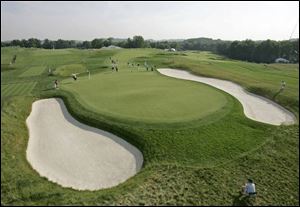
Pin placements will set scores at U.S. Open
6/14/2007
Extremely fast, undulating greens are what set Oakmont apart from other U.S. Open venues. Pin placement will be critical.
OAKMONT, Pa. - This was no magic trick, just Oakmont.
Steve Stricker was standing next to his bag marking his golf balls before his final practice round yesterday at the U.S. Open when he dropped one on the green. He watched it trickle around the bag, appear on the other side and hit someone in the foot, a 180-degree turn over an area of five feet.
The smile on his face disguised a wince.
Stricker is among the best putters in golf, and even he took a breath on the eve of an Open that will be held on a course reputed to have the fastest greens in the land.
This is his 12th U.S. Open, and he has come to expect narrow fairways, shaggy rough, firm greens, frayed nerves.
"The setup is comparable from the tee until you reach the green," Stricker said. "But once you hit the green, it's another game."
More than its reputation as the toughest course in America, more than the Church Pew bunkers, with or without 5,000 trees, what sets Oakmont apart from other U.S. Open venues is the greens.
Oakmont opened in 1903, and while there have been changes over the years, the greens remain virtually untouched.
"Everything else out there is similar U.S. Open," defending champion Geoff Ogilvy said. "The greens here are something different. They are amazing greens, probably some of my
favorite greens I've ever seen. They run a bit faster than they should in spots."
How fast?
Ogilvy said he would rather be in the rough below the hole than on the putting surface above the hole.
It should not have been surprising to see so much activity on the putting green, an extension of the ninth green at Oakmont. Tiger Woods took the day off, except to hit balls on the range and work on his putting. He hit one that missed on the low side and then rapped another that found the bottom of the cup while the first one continued to roll away until he walked over to pick it up.
"They are by far the most difficult greens I've ever played," Woods said. "I thought Winged Foot was pretty tough. Augusta is pretty tough. But both courses have flat spots. Augusta may have these big, big slopes, but they have these flat shelves that they usually put the pins on. Here, I'm trying to figure where a flat shelf is."
Mike Davis, the senior director of rules and competition who sets up the course, set a tube of lip balm on the top part of the second green and was gently stroking putts at it.
"We're trying to see what to do with the four hole locations," Davis said. "Actually, we're trying to find four hole locations."
That's why Padraig Harrington suggested earlier this week that the USGA has more control of the scoring at Oakmont than perhaps any other course it visits. Stick the pins in tough spots and no one breaks par. Find more gentle sections of the green, and there's a chance.
"I wouldn't be putting my house that 8 over par is going to win this tournament, but I think it's certainly got a chance," Harrington said. "If the USGA wants us to shoot level par this week, the winning score will be level par. It's much more in their control than it is in any player's control. If somebody goes out and shoots 66 the first day, God help us."
The rough is thick enough that most players doubt they will be able to get out of it and onto the greens. That's not unusual at a U.S. Open. The smart play is to wedge out of the hay, leave 100 yards to the green and try to hit another wedge close to the hole.
"You hit that wedge shot that takes a big hop and stops," Stricker explained. "But here, it takes the big hop and stops, and then it continues to roll. And when you're on the green, some of those putts are treacherous. You think you've hit a decent putt, and it keeps trickling away. It's tough to get inside that four to five-foot area, and you better make those."
Weather will dictate degree of difficulty, as always. Thunderstorms developed late yesterday, but otherwise there's no rain in the forecast.
Oakmont was soaked the day Johnny Miller shot 63 in the final round to win in 1973, but it still was a round that might never be matched. Not this year, anyway.
"I could put a great player on every green 15 feet away, and he's not going to make nine of them," Oakmont head pro Bob Ford said.